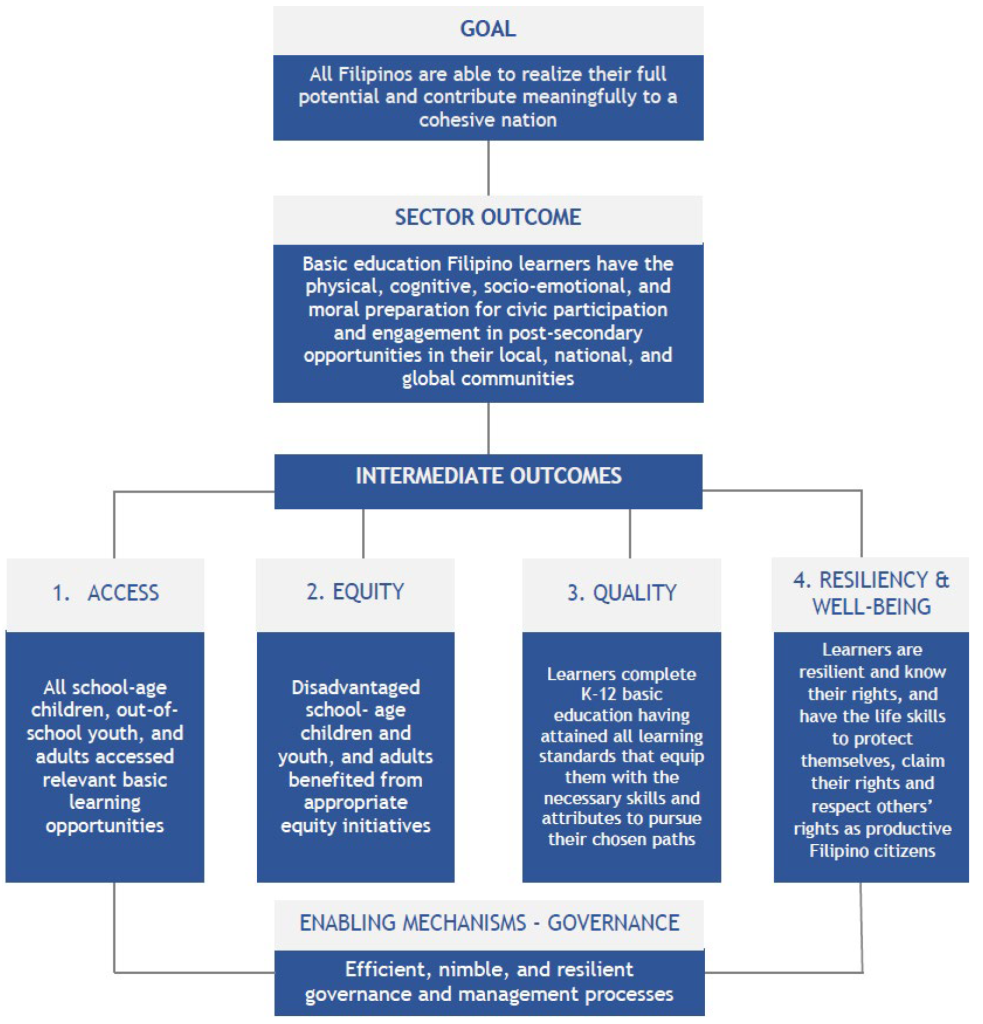The Department of Education (DepEd) issues the enclosed policy on the Adoption of the Basic Education Monitoring and Evaluation Framework (BEMEF) to guide DepEd operating units across governance levels in the conduct of Monitoring and Evaluation (M&E).
The rules and standards prescribed by this policy supports the global and national commitments of the Department in delivering basic education in the country. This is also aligned with the Basic Education Development Plan (BEDP) 2030 of the Department.
The BEMEF provides the DepEd organizational and learner outcomes. Specifically, the framework aims to
a. ensure that the agency’s plans, policies, systems, and processes are geared towards the achievement of organizational and learner outcomes;
b. set the performance measures of the agency where all operating units are expected to contribute;
c. guide DepEd bureaus, services, regional and schools division offices, schools, and learning centers in developing their respective M&E plan; and
d. define the roles and responsibilities of DepEd operating units in the M&E system and processes. BEMEF further supports the institutionalization of a results-based M&E system which will provide DepEd with informed and evidence-based decision-making and policy development process, as well as improved allocation and management of government resources, for improved transparency and accountability, in the basic education sector.
This Order shall take effect immediately upon its approval. Its certified copies shall be filed with the University of the Philippines Law Center-Office of the National Administrative Register (UP LC-ONAR), UP Diliman, Quezon City.
All existing Orders, Memoranda, and other related issuances inconsistent with this policy are repealed, rescinded, or modified accordingly.
For more information, please contact the Planning Service-Policy Research and Development Division, 2nd Floor, Alonzo Building, Department of Education Central Office, DepEd Complex, Meralco Avenue, Pasig City through email at ps.prd@deped.gov.ph or telephone number (02) 8635-3976.
Immediate dissemination of and strict compliance with this Order is directed.
Table of Contents
Adoption of the Basic Education Monitoring and Evaluation Framework (BEMEF)
Rationale
Pursuant to Republic Act (RA) 9155 or the “Governance of Basic Education Act of 2001” and RA 10533 or the “Enhanced Basic Education Act of 2013”, the Department of Education (DepEd) implements programs, projects, and major activities to ensure access to and improve the quality of basic education, an end toward which all operating units at all governance levels have attendant roles, tasks, and responsibilities for which they are principally accountable.
Relative to this, the Department of Education develops the Basic Education Development Plan (BEDP) 2030 which responds to issues and challenges in basic education as well as the global and national education commitments. The BEDP 2030 aims to continue the goal of the Department that all Filipinos can realize their full potential and contribute meaningfully to a cohesive nation through the protection and promotion of the right to education. It is a longterm plan for basic education anchored on the Sulong Edukalidad Framework, the Philippine Development Plan, Ambisyon Natin 2040 and the commitments in the Sustainable Development Goals (SDG) 2030, and provides a strategic roadmap for the Department to follow to improve the delivery and quality of basic education and the experience of learners in the basic education learning environment.
In support to this, DepEd developed this policy framework on Basic Education Monitoring and Evaluation Framework (BEMEF) to track and measure the achievement of BEDP 2030. In addition, BEMEF is integrally linked to the planning and budget strategy of the Department. In particular, BEMEF explicitly identifies and articulates the indicators and targets for measuring performance in the development of plans and policies of all DepEd operating units at all governance levels. It intends to complement the planning and budget strategy by setting up the framework for agency-wide monitoring and evaluation (M&E).
As the DepEd expands its efforts to improve delivery of basic education services, it also introduces reforms by improving its internal processes and systems towards improved accountability and transparency. In this regard, it seeks to strengthen its evidence-based decision-making. The BEMEF is consistent with the principles adopted by oversight agencies such as National Economic Development Authority (NEDA) and Department of Budget and Management (DBM) in implementing the Program Expenditure Classification (PREXC)1, National Evaluation Policy Framework of the Philippines (NEPF)2 and the Adoption of a Results-based Monitoring and Evaluation Reporting (RbMER) Policy3.
1 Program Expenditure Classification (PREXC) by the Department of Budget Management (DBM), the logical continuation of Performance-Informed Budgeting (PIB). It reflects in the budget the link between strategies, budgets and results and facilitates the monitoring and evaluation of programs with the performance indicators attached to each program.
2 Joint Memorandum Circular (JMC) 2015-1 dated July 15, 2015: National Evaluation Policy Framework of the Philippines (NEPF) by the DBM and the National Economic Development Authority (NEDA), a framework to guide the purposive conduct of evaluations in the public sector in support of good governance, transparency, accountability, and evidence-based decision making in public sector’s programs and projects and activities.
3 National Budget Circular No. 565 dated December 2, 2016 (NBC No. 565 s. 2016): Adoption of a Results-based Monitoring and Evaluation Reporting (RbMER) Policy which aims to strengthen, streamline, and standardize the RbMER system evidence through the timely, useful, accurate, and credible reporting of performance information in order to support policy and program improvement, expenditure management, and local and national decision-making.
Hence, the BEMEF is developed to establish the roles and responsibilities of DepEd operating units in conducting monitoring and evaluation (M&E), set the systems and processes of the organization, and firm-up indicators to reflect the agency performance and goals. This shall strengthen evidence-based building to contribute to decision-making, policy formulation and program development, as well as strengthen transparency and accountability in the basic education sector.
Scope of the Policy
BEMEF along with the structures and mechanisms, shall be adopted and implemented by all DepEd operating units in all governance levels. It identifies DepEd operating units with oversight M&E functions and articulates the M&E processes that shall be performed at each governance level.
Definition of Terms
For the purpose of this policy, the following terms are defined and understood as follows:
any decision-making unit of DepEd at the national, regional, school division, or school levels in charge of providing directives and determining strategies to achieve agency performance targets.
any DepEd unit across governance levels that provides support and/or implement programs, projects, and major activities relative to the delivery of basic education in line with the provisions of R.A. 9155.
a document that provides guidance on the purpose and process of conducting monitoring and evaluation of any programs, policies, projects, office mandates, and activities. This contains scope and purpose of M&E, data collection and management plan, data analysis plan, and M&E results reporting, dissemination, and utilization
a set of organizational structures, management processes, standards, strategies, plans, indicators, information systems, reporting lines and accountability relationships which enables offices across governance levels to perform their M&E functions effectively.
instruments used to collect information during the conduct of monitoring and evaluation.
the staff with the overall authority, accountability, and responsibility for the M&E system at each governance level
the office that will oversee and manage the conduct of the M&E system per governance level
a DepEd operating unit at the national, regional, school division, or school level in charge of executing tasks or deliverables.
continuous process of collecting and analyzing information to compare how well DepEd programs, projects, and activities are performing against its expected outcome or result.
Policy Statement
The Department hereby establishes the Basic Education Monitoring and Evaluation Framework (BEMEF) to ensure that the agency’s plans, policies, systems and processes are geared towards the achievement of organizational outcomes. It sets the performance measures for the agency where all operating units are expected to contribute. This framework shall also guide DepEd bureaus, services, regional and schools division offices, schools, and learning centers in developing their respective M&E plan. Lastly, it shall define the roles and responsibilities of DepEd operating units in the M&E system and processes.
The guiding principles by which the Department will implement its M&E system and processes are governed by the following:
a. M&E should contribute to improved governance. This entails increased transparency and accountability among education leaders and implementers, increased participation and inclusion of various interests of all types of education stakeholders, and overall institutionalization of evidence-based decision-making in the education sector.
b. M&E should be development oriented. M&E results should be applied to improve organizational and individual performance and to contribute to continuous learning and improvement towards better delivery of education services.
c. M&E should be undertaken ethically. There is sensitive and responsible implementation of M&E processes with respect to the privacy, values, and culture of involved stakeholders. Reporting should be fair and provide a balanced account of findings.
d. M&E should be utilization oriented. M&E data and information is strategically gathered to responsively meet the needs of the organization. An accessible and organized central repository of M&E reports, data, and indicators is maintained for strategic utilization during planning, policy development, program designing, and resource allocation.
e. M&E should be methodologically sound and appropriate. Conduct of M&E follows an established set of standards guided by a common set of organizational indicators. The M&E methods and/or approaches to be used are fit-for-purpose to the nature and state of intervention applied. M&E findings should be systematically analyzed and triangulated for improved credibility.
f. M&E should be operationally effective. To ensure that M&E will be effective and properly managed, it should be embedded in implementation plans, allocated with sufficient resources. It should also have a defined scope and clear purpose. Systematic integration of M&E in organizational operations makes it more resilient to administrative changes.
g. M&E should be a shared responsibility. M&E is a critical element for an organization to achieve its goal. As members of an organization with a similar goal, each has a responsibility to conduct M&E that will support evidence-based decision-making towards better achievement of the goal.
Basic Education Monitoring and Evaluation Framework (BEMEF)
The BEMEF, as illustrated in Figure 1, links the means and ends as well as interrelationships of various programs, structures, and systems. It is organized in four levels: (i) Goal, (ii) sector outcome, (iii) Intermediate Outcome (IO), and (iv) Enabling mechanisms (EM). The goal represents the contribution of the Department in achieving societal aspirations in terms of improving the state of education in the country and global community4. The sector outcome represents the result that DepEd would like to attain as an organization. It also encompasses the strategic directions and agenda of the Department as an agency. It describes the condition and characteristics of the learners the organization wants to produce – what we want our learners to be after they complete basic education. DepEd aims to develop Filipino learners with physical, cognitive, socio-emotional, and moral preparation for civic participation and engagement in post-secondary opportunities in the local, national, and global communities. It seeks to reinforce current measures of learning outcomes to recognize diversity of talents and intelligence. It ensures that policies and programs aimed at addressing the holistic needs of learners are implemented. The IO represents what the DepEd as an organization endeavors the learners to be while inside the basic education system in terms of access and quality. Relatedly, the EM defines the necessary governance structure in terms of leadership investments, management systems, partnerships, and external relations that will ensure the effective, efficient, and responsive delivery of basic education needs of the learners. The EMs shall create the enabling conditions needed to achieve the IOs.
All basic education plans shall subscribe to the IOs and EMs, as applicable. During the planning stage, each operating unit shall identify targets and implementation strategies that will contribute to the achievement of the agency’s IOs and EMs. To further define the intermediate and enabling mechanism outcomes:
IO 1. All school-age children, out-of-school youth, and adults accessed relevant basic learning opportunities – All learners, regardless of sex, religion, geography, financial disposition, have access to and are encouraged to attend schools and learning centers. This ensures that schools and learning facilities are made accessible to all types of learners.
IO 2. School-age children and youth, and adults in situations of disadvantaged benefited from appropriate equity initiatives – School age children and youth, and adults who are most vulnerable and disadvantaged in terms of access to learning as indicated in the eligibility of learners: indigent children, out-of-school youth, distressed individuals and families, including internally displaced personas (IDPs), low resourced students, abandoned and neglected children, street children, children of former rebels, children living in conflict-affected areas and vulnerable communities (CVAS), children with disabilities, children from Geographically Isolated and Disadvantaged Areas (GIDA) have access to schools, learning centers, and all education resources and facilities. This ensures that no child and youth is left behind in the education system and reach their full potential as active members of their communities and the Philippine society.
IO 3. Learners complete K-12 basic education having attained all learning standards that equip them with the necessary skills and attributes to pursue their chosen paths -Programs and initiatives aimed at ensuring learners benefit from their completion of the basic education cycle and from any other educational interventions, and are learning/ gaining knowledge are implemented. It recognizes that attendance to school and learning centers is not sufficient to deliver quality basic education.
IO 4. Learners are resilient and know their rights and have the life skills to protect themselves and claim their education rights from DepEd and other duty-bearers to promote learners’ well-being – All learners in adverse contexts recover and even thrive and exercise their rights. Learners potentially exposed to hazards, shall have the capacity to adapt. This adaptation means resisting or changing in order to reach and maintain an acceptable level of functioning and structure.
EM 1: Education leaders and managers practice participative and inclusive management processes – Improve capacity on participative and inclusive management processes of education leaders and managers. It ensures that design and implementation of professional development programs are relevant and appropriate to the required skills and competencies.
EM 2: Human resources in all governance levels are sufficient, resilient, competent, and continuously improving – Meet the sufficient human resource requirements at all governance levels. Ensure that the professional development standards, employee welfare and benefits standards are responsive to the demands of quality, inclusive, and rights-based education.
EM 3: Investments in basic education provide learners with the ideal learning environment – Sufficient provision and equitable distribution of education resources. It also recognizes the gaps and immediate measures that need to be considered in prioritizing resources in the midst of competing education priorities to achieve equity and impact.
EM 4: Improve and modernize internal systems and processes for a responsive and efficient financial resource management – Enhance people’s capacity, functional and leadership competencies, internal systems and processes to efficiently and effectively deliver basic education services.
EM 5: Key stakeholders actively collaborate to serve learners better – Ensure the collaborative engagement with key stakeholders to achieve basic education goals. This will be delivered through functional mechanisms to make partnership building and linkages more strategic and aligned to DepEd priorities.
EM 6: Public and private education operate under a dynamic and responsive complementarity framework – Reinforce the role of private education to complement the implementation of the basic education curriculum.
The mandates5 of DepEd operating units, as defined by existing laws and policies, shall serve as guidance in identifying their contributions to achieve the EM performance indicators. The Office Functions, which defines the key result areas of all DepEd operating units as translated in the Results-based Performance Management System6 (RPMS) and planning tools (i.e., investment plan, operational plan, among others) shall determine the outputs and outcomes. The office functions which may range from the development of responsive and relevant curriculum; the provision of effective learning delivery; ensuring a learner-friendly environment, shall contribute to the achievement of the EMs and IOs. The BEMEF shall guide the offices in developing their respective M&E plans to capture office-specific outcomes. In this manner, the collective attainment of office outcomes will create the enabling environment that will contribute to the realization of IOs, organizational outcome, and the societal goal of the Department.
DepEd Performance Indicators
The BEMEF provides the basis for measuring the performance of the Department in terms of achieving the IOs and EMs. In order to determine if DepEd is achieving each IO and EM, a set of performance indicators were identified. These define the data collection requirements and processes that shall contribute to evidence-based decision making.
Since IO and EM statements in the BEMEF are governed by, and complementary to global and national commitments, and strategic directions of the Department, all operating units across governance levels shall subscribe to the achievement of the agency performance indicators. This includes the identification of performance indicators appropriate to the governance level or operating unit.
Table 1 enumerates and articulates the agency performance indicators that shall measure DepEd’s organizational performance. Table 1.1 includes the description, frequency of data reporting, data disaggregation, and data source for each IO performance indicator, whereas Table 1.2 includes the description, frequency of data reporting, data disaggregation, and accountable offices for each EM performance indicator.
The implementation of these indicators will be divided into three tiers which are as follows:
- Tier 1 indicators are those that are readily available in our current information systems and administrative data.
- Tier 2 indicators are those currently under development and/or with ongoing policy initiatives.
- Tier 3 indicators are those that are yet to be developed.
5 Republic Act No. 9155- An Act Instituting a Framework of Governance for Basic Education, Establishing Authority and Accountability, Renaming the Department of Education, Culture and Sports as the Department of Education, and for other Purposes (Governance of Basic Education Act of 2001); Department Order No. 52, s. 2015- New Organizational Structures of the Central, Regional, and School Division Offices of the Department of Education
6 Department Order No. 02, s. 2015 – Guidelines on the Establishment and Implementation of the Results-Based Performance Management System (RPMS) in the Department of Education
Table 1. Agency Performance Measurement Matrix
Table 1.1. Intermediate Outcome Performance Indicators
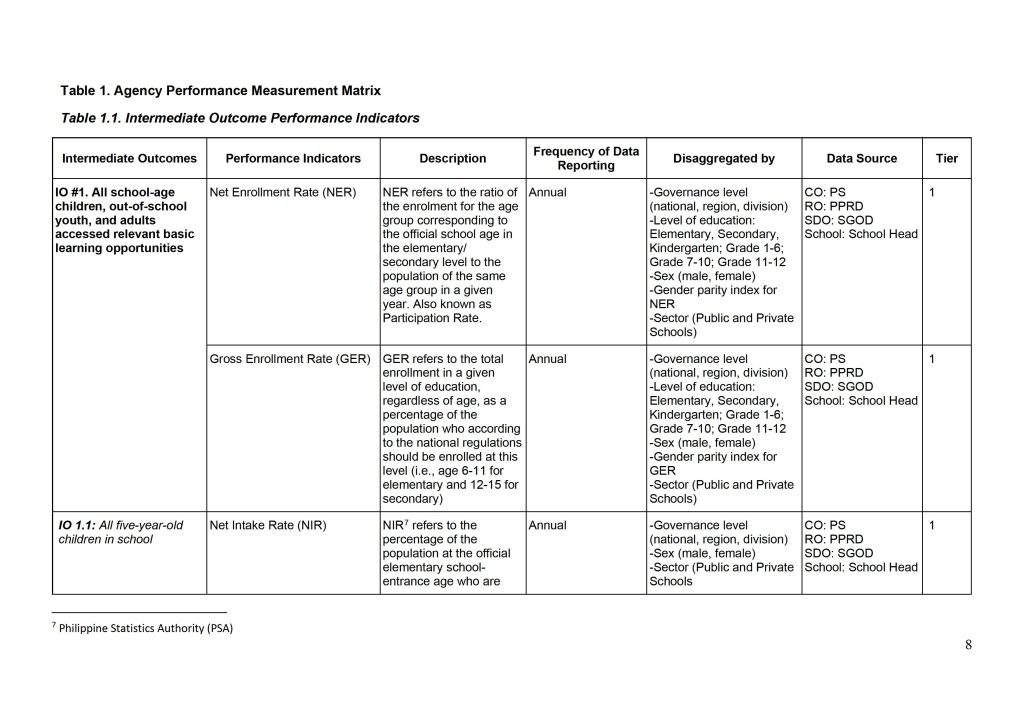
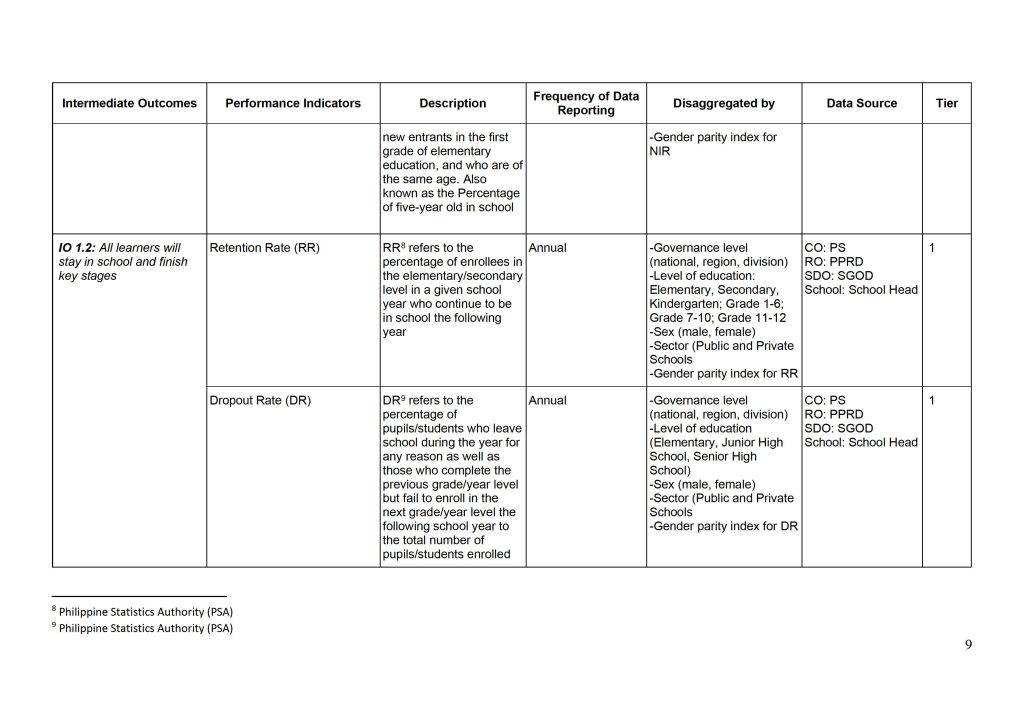
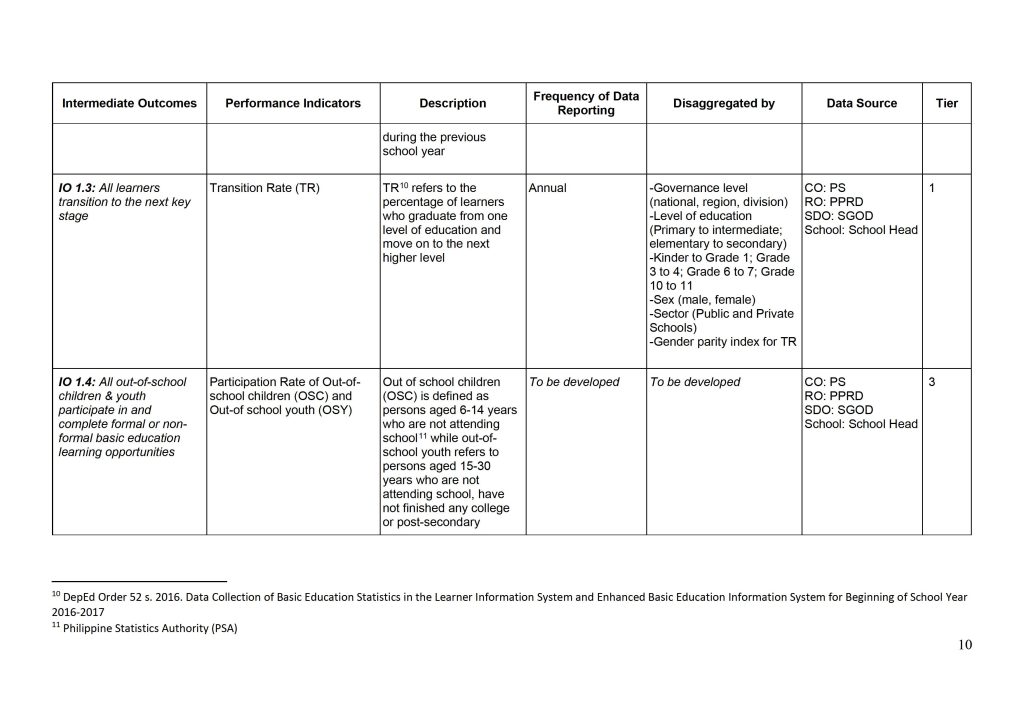
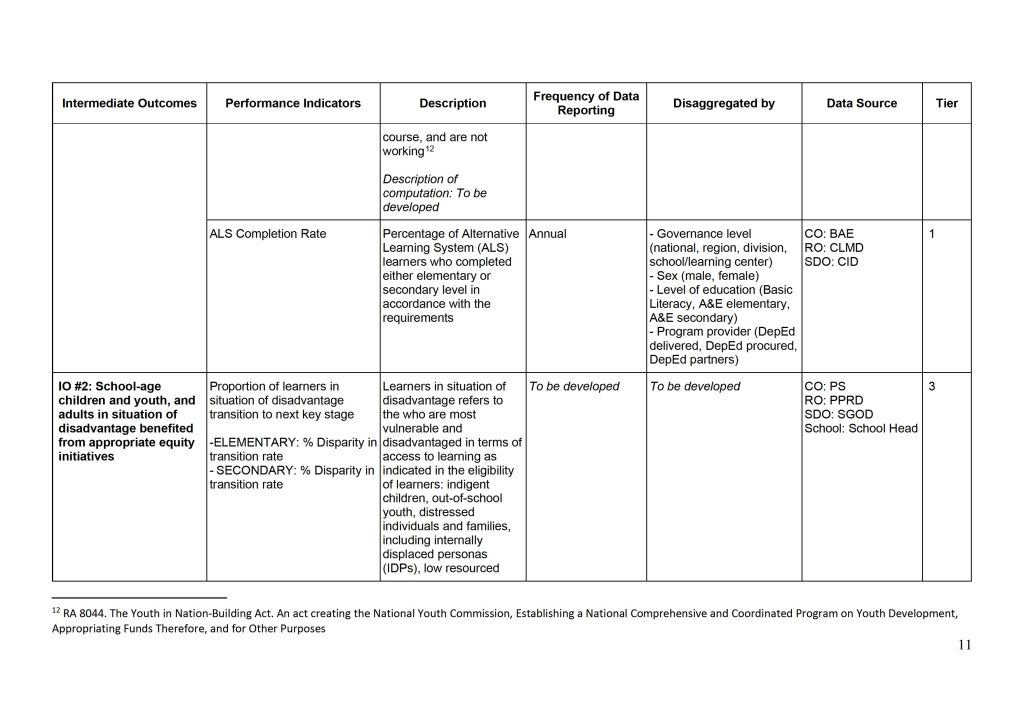
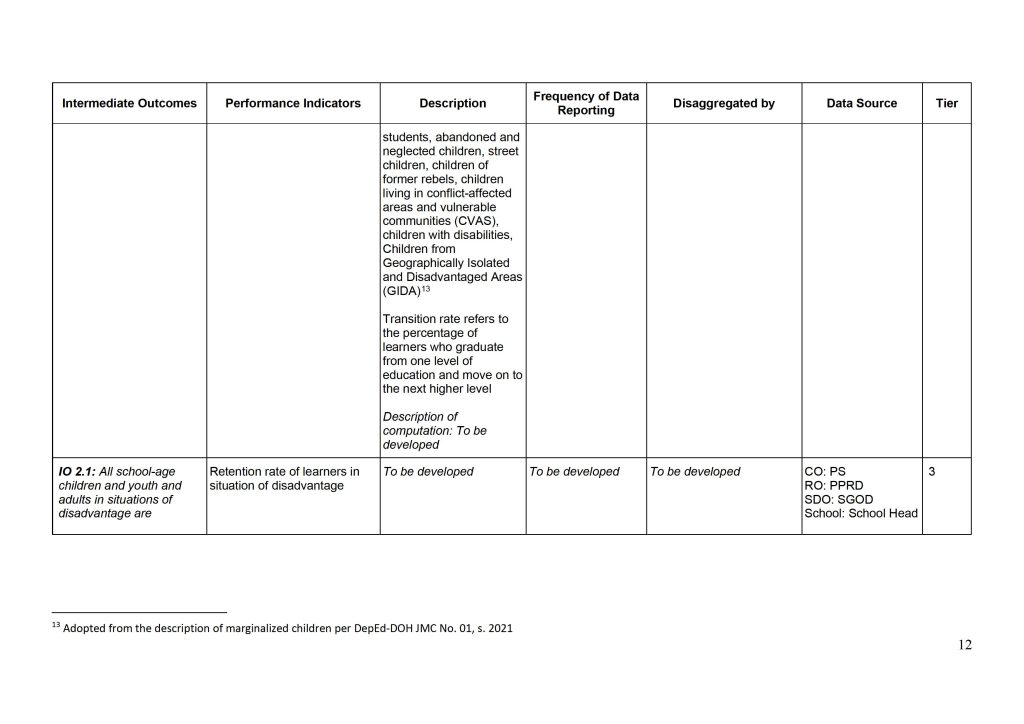
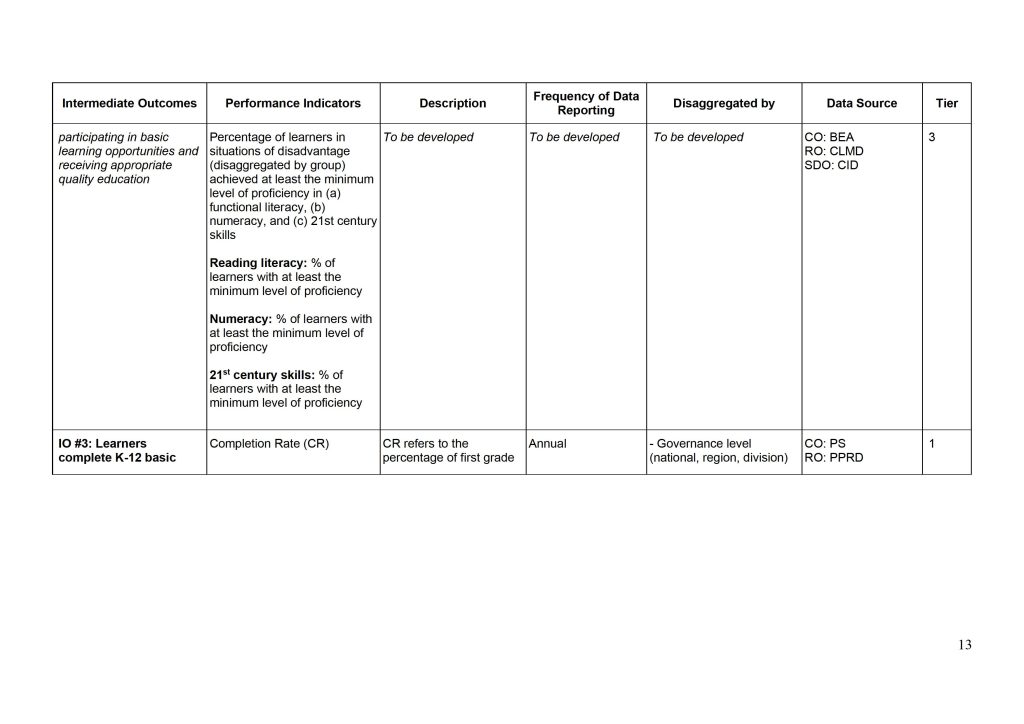
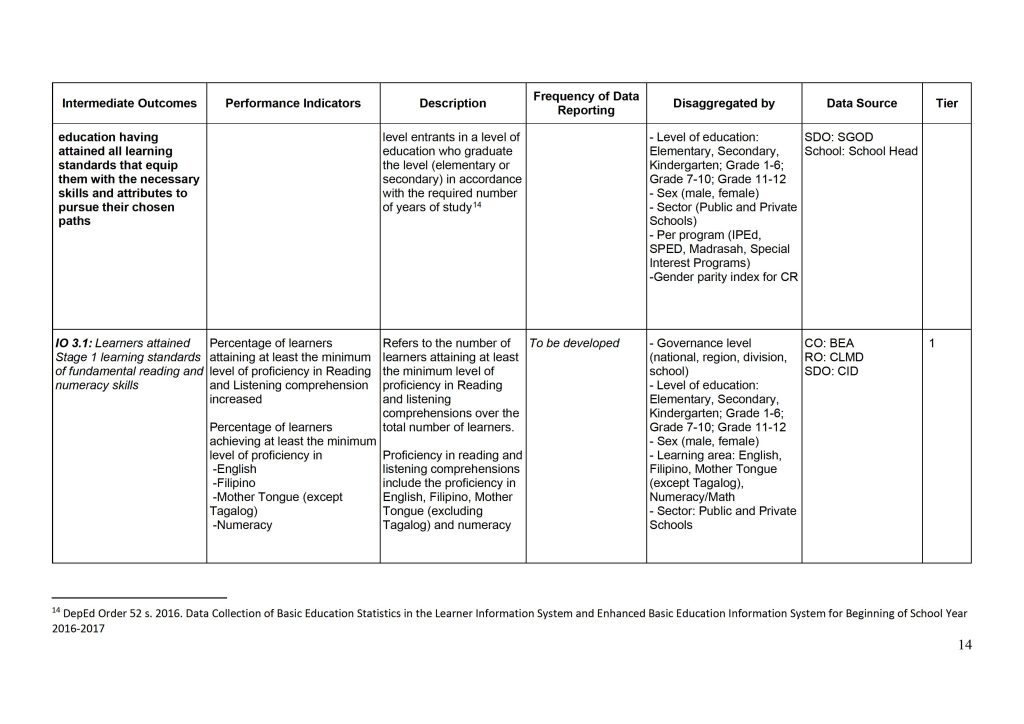
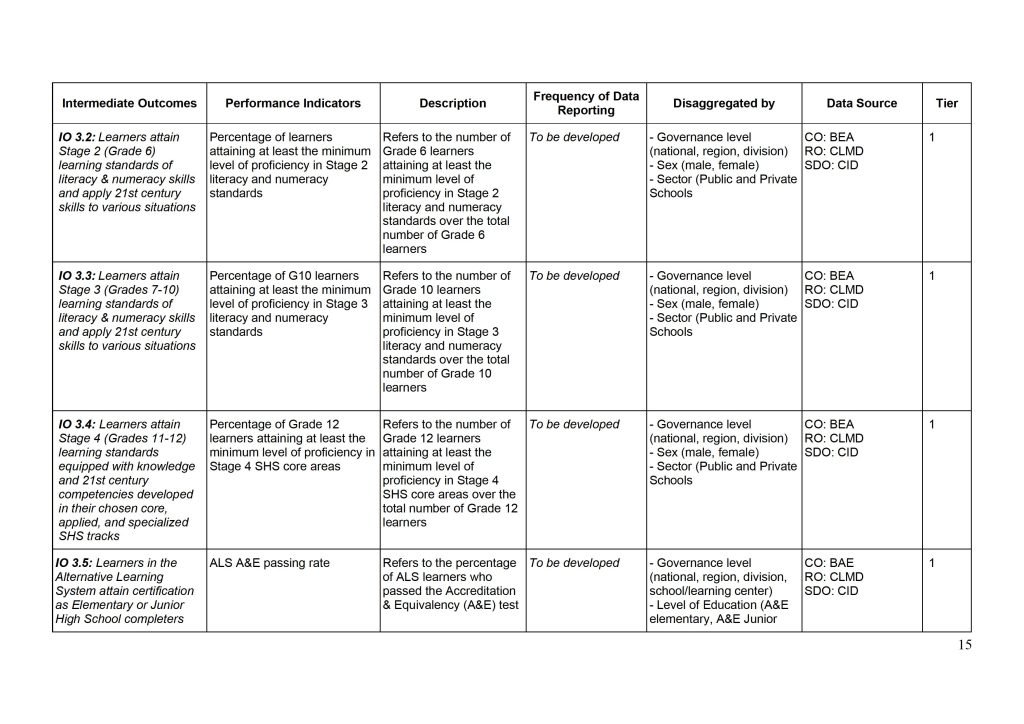
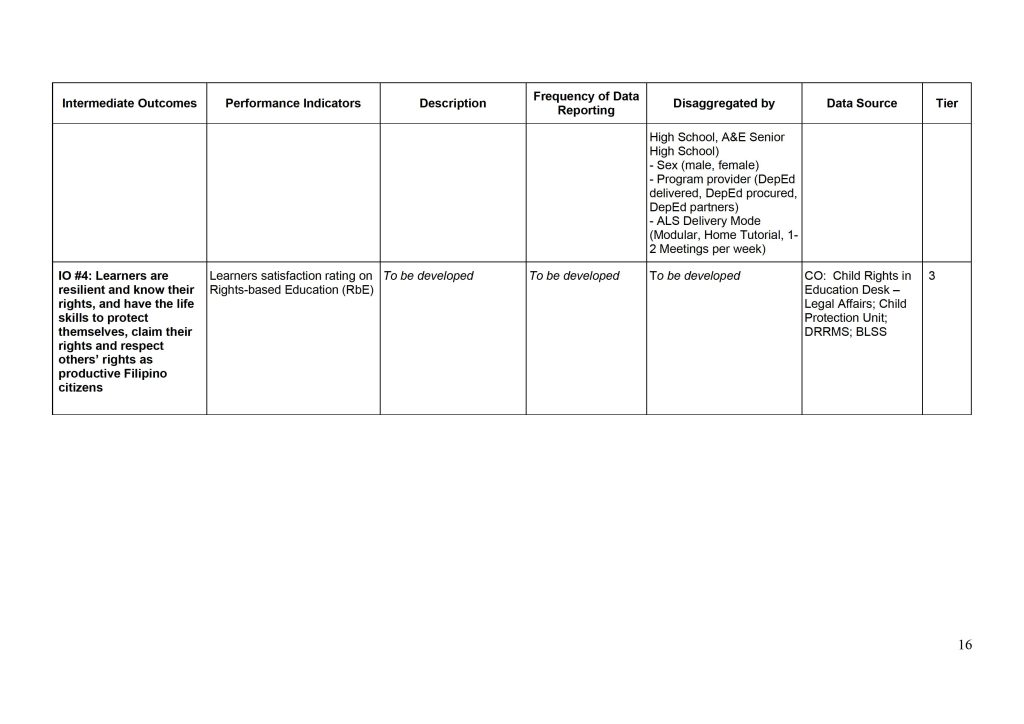
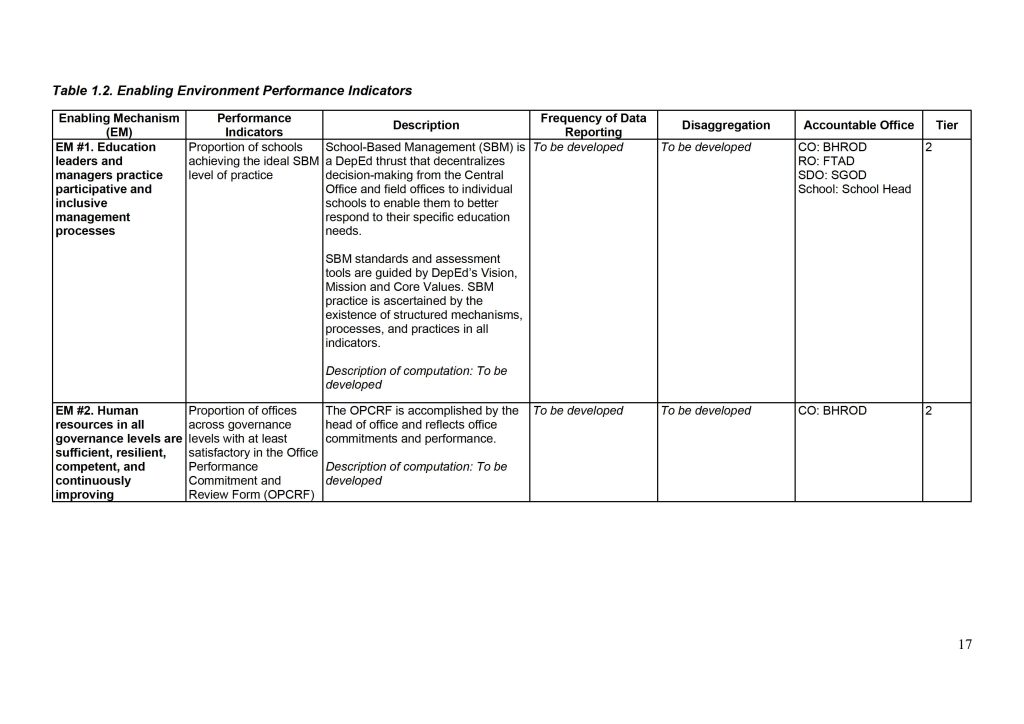
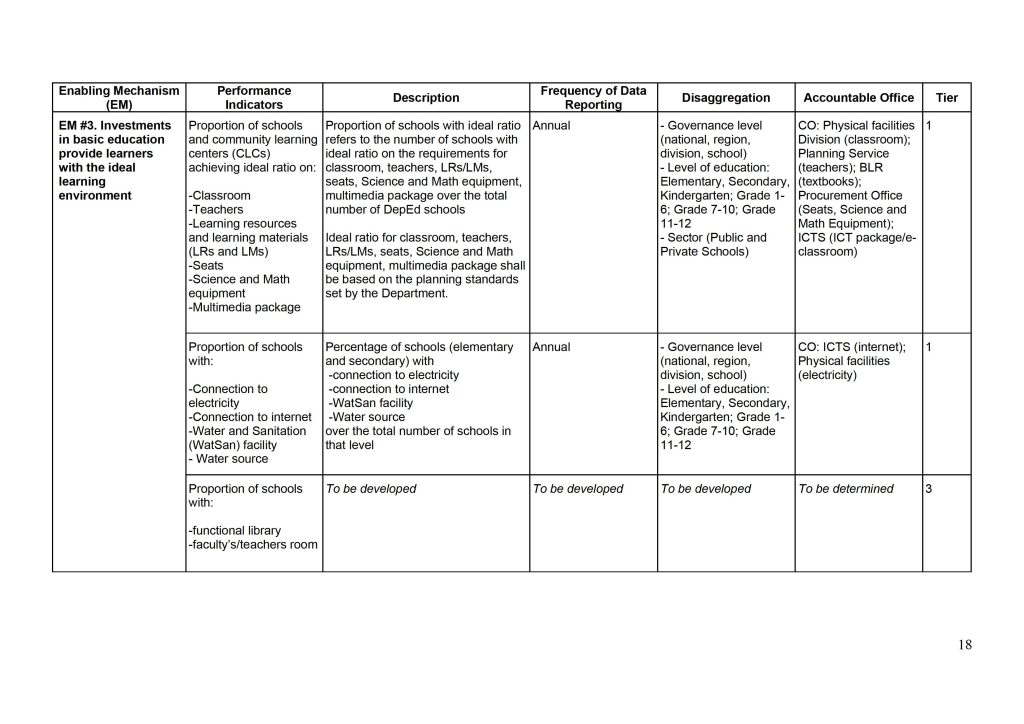
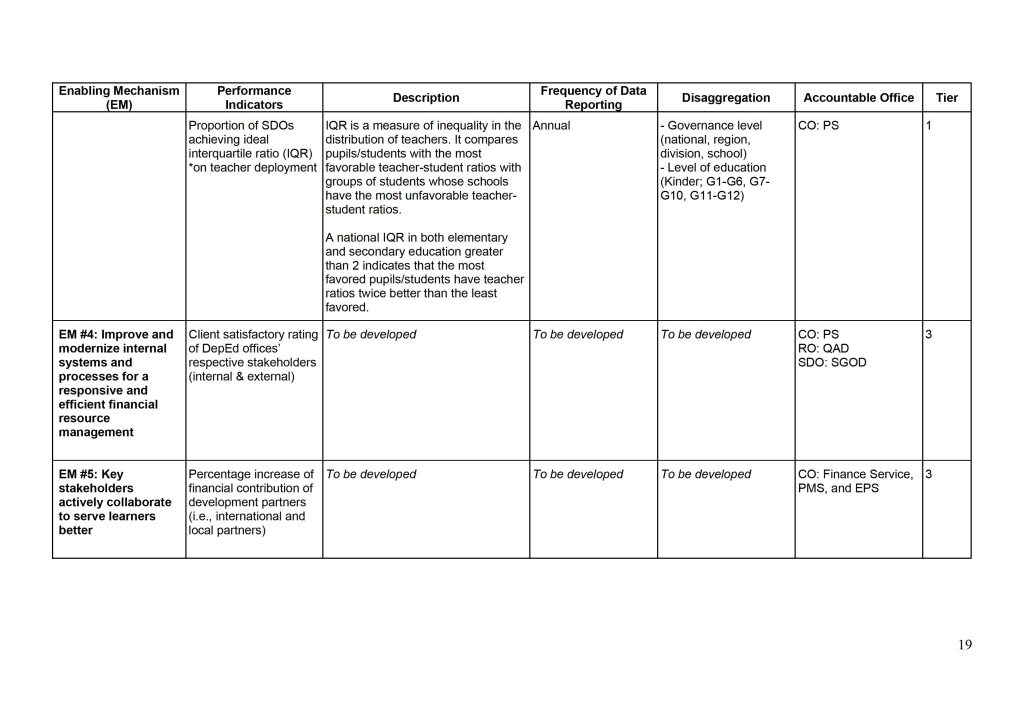
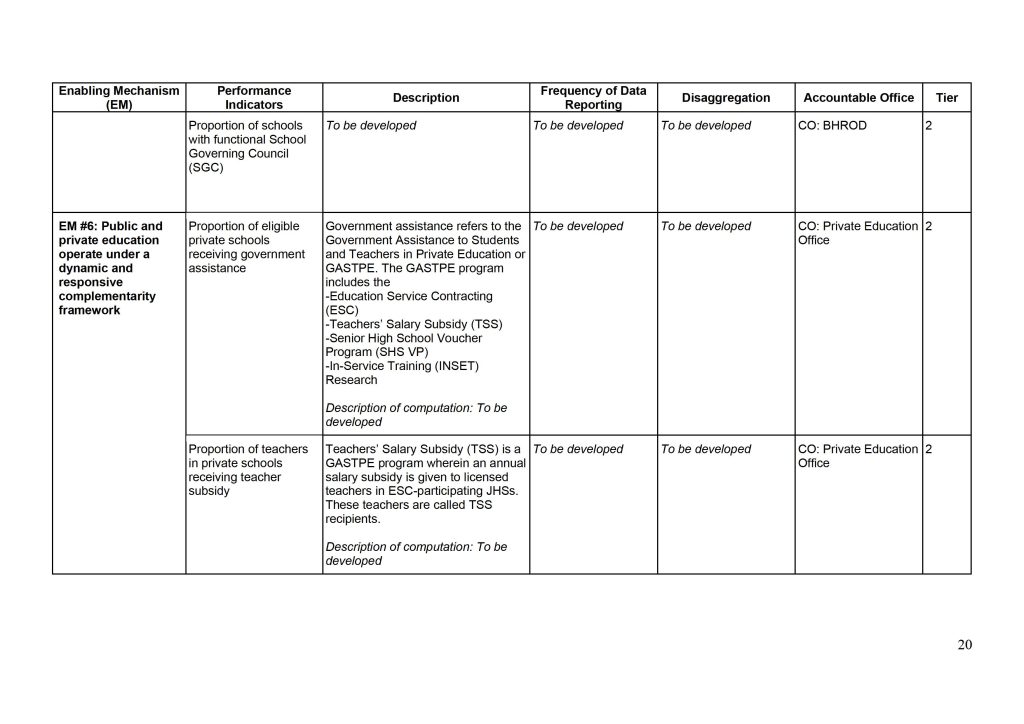
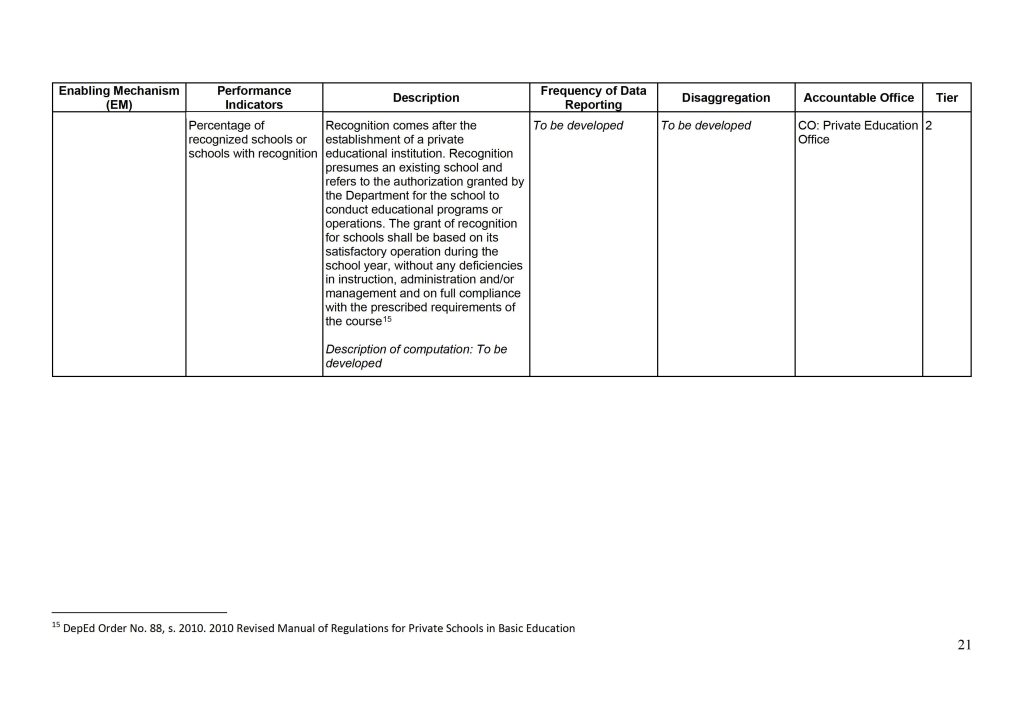
The above-mentioned indicators are agency level indicators that reflect our global and national commitments as well as DepEd’s strategic directions. All operating units shall ensure that their plans, programs, and policies contribute towards the attainment of these indicators. In the conduct of their M&E, each governance level shall ensure the alignment of their performance indicators with the agency level indicators.
The overall lead of each M&E system, namely the Secretary, Regional Directors, School Division Superintendents, and School Heads shall decide on which performance indicators should be added in their respective M&E plans as discussed in section VIII (Roles and Responsibilities of Offices) of this policy.
Monitoring and Evaluation Mechanisms
The BEMEF shall guide the conduct of M&E in DepEd. To identify the appropriate M&E mechanisms, tools, and approaches to use, it is important to have a clear understanding of the difference between monitoring and evaluation, and the different types of M&E being conducted at each stage of programs, projects, and major activities implementation.
Monitoring and evaluation (M&E) are processes that both refer to the measurement of the performance of an organization, a program, a project, or an individual. These are complementary yet distinct processes depending on the purpose, focus, and approach used when they are conducted. The activities involved in monitoring and evaluation are often intertwined, but clear distinctions exist between the two.
Monitoring16 explains the efficiency and effectiveness of operations while evaluation provides information on the benefits achieved. Results of monitoring provide bases for critical management decisions such as resource allocation or realignment, target setting, remedial/corrective actions or strategy development. On the other hand, evaluation results provide valuable lessons and insights that can be used by managers in crafting strategic decisions for the future such as in designing organizational changes or future programs and/or projects.
Types of M&E
The types of monitoring and evaluation that shall be used by DepEd operating units across governance levels are described as follows:
Monitoring. This is a systematic and objective assessment of an on-going implementation of plans, programs, projects, and major activities. It aims to steer implementation as efficiently as possible based on empirical facts determined through verifiable assessment process, systematic observation and documentation. This also determines any adjustment of plans and activities needed to achieve the committed targets. Monitoring may be done on a weekly, monthly, or quarterly basis depending on the M&E Plan.
All DepEd operating units shall conduct monitoring of their respective programs, projects, and major activities. This may require M&E tools for the data collection and the concerned operating unit shall be responsible for developing relevant and appropriate tools to assess the implementation of its programs, projects, and major activities. Monitoring results immediately inform the program, project, and activity implementers in the necessary adjustments in their plans so they can achieve their target outputs and outcomes. Results primarily focus on operational concerns that affect the implementation of programs or projects which may include a need for additional funding support, adjustments in logistical arrangements, and other-related concerns.
The Program Management Information System (PMIS)17 is one of the mechanisms in doing monitoring in DepEd and currently the official source of data on programs, projects and activities (PPAs) from planning to implementation. It aims to support the effective and efficient management of plans and programs; increase transparency of plans and programs at all levels of governance; provides a platform that encourages a more careful and systematic preparation of plans and utilization of budget; aids in policy formulation and decision making; and enforce standards for planning and plan implementation. DepEd obtains timely information about the performance of programs, projects, and major activities and allows it to provide timely response to bottlenecks, constraints, and challenges affecting the delivery of basic education services.
In support of monitoring and evaluation, PIR is established as the reporting platform of DepEd operating units at all governance levels. The PIR is conducted on a quarterly basis to report the accomplishments of outputs in terms of efficiency, and corresponding utilization of the budget. Through this mechanism, a separate guideline shall be provided on the conduct of PIR.
Process Evaluation. Determines the effectiveness and efficiency of the implementation processes and systems. This could be conducted at any phase of the plan implementation and could be combined with other types of monitoring. Through this evaluation, issues and challenges in program, project, and activity deliveries can be addressed.
Results Evaluation. This is an evaluation approach that focuses on measuring the realization of results. It seeks to assess the outcomes and changes brought about by program or project interventions. Findings from this type of evaluation are used as the baseline situation for the next planning cycle.
All DepEd operating units across governance levels shall conduct process evaluation. However, the conduct of outcome and impact evaluations of programs, projects, and major activities shall be done by internal and external parties across governance levels not involved in the implementation of particular plans and programs.
M&E Plan
In operationalizing the conduct of M&E, all operating units are required to develop M&E Plans for their respective education plans, programs, and policies. The M&E Plan is a document that provides guidance on the purpose and process of conducting monitoring and evaluation of any programs, policies, projects, office mandates, and activities.
The M&E plan contains four (4) core M&E processes that are critical in conducting the M&E: (1) establishment of scope and purpose of M&E, (2) data collection and management, (3) data analysis, and (4) M&E results reporting, dissemination, and utilization. The development of tools for data collection/requirements shall be guided by the M&E Plan to be established per program, policy, and plan.
Operations manual shall be issued to discuss the details and procedures on how to develop the M&E plan that captures the four core processes.
Monitoring and Evaluation System per Governance Level
The M&E system shall serve as an integrating mechanism across governance levels and within operating units of the Department. This shall provide the DepEd’s decision-makers with evidence-based information on the applicability and feasibility of formulation and implementation of policies, programs, projects, and major activities in the Department.
The vertical integration of the M&E system across governance levels is the systematic alignment of development and implementation of basic education plans, policies, programs, projects, major activities, and M&E processes from national to region, region to school division, and school division to school level and vice versa. It allows the national, regional, school division, and school levels to make adjustments in the quality of their strategic basic education plans including technical, human resource, and administrative services. Likewise, the horizontal integration of the M&E system within governance levels shall align the development and implementation processes of basic education plans, policies, programs, projects, major activities, and M&E processes among operating units in a particular governance level i.e. national, regional, school division, and school. BEMEF shall enable each office to come up with a more holistic and integrated analysis of their entire governance situation. To make the M&E system functional, all DepEd operating units across governance levels shall conduct the M&E of their respective basic education plans, policies, programs, projects, and major activities in accordance to BEMEF and corresponding standards.
To guide the Department in operationalizing the BEMEF, the M&E structure and system of each governance level are described in the succeeding sections.
National M&E System
The national M&E system shall orchestrate and define the scope of the entire DepEd M&E System. This includes continuous review and enhancement of performance indicators to ensure that the needs of learners are addressed.
The national M&E system shall:
a. Establish a results-based M&E at all levels;
b. Provide the mechanism for the horizontal integration of bureaus, services and other operating units at the national level;
c. Ensure vertical integration of the M&E systems in the region, school division, and school;
d. Define the processes for validating outcomes and accomplishments. This includes design of M&E work processes, identification of the information needs of internal and external stakeholders, report requirements, and process for collecting and capturing data and information;
e. Ensure the integration of M&E results in development policies, programs and plans, preparation of the agency’s financial requirements and distribution of resources;
f. Facilitate exchange of information, practices, insights, lessons and issues between and among operating units and external stakeholders;
g. Facilitate the implementation of third party evaluation of DepEd programs and projects;
h. Link M&E results to the organizational and individual performance; and
i. Ensure that BEMEF is supportive of the achievement of DepEd goals and outcomes.
Regional M&E System
The regional M&E system shall ensure the effective, efficient, and inclusive implementation of all education policies & programs and the achievement of desired outcomes. The regional M&E system shall provide the regional policy makers and implementers with timely and appropriate feedback on the implementation of DepEd policies, programs, and delivery systems.
The regional M&E system shall:
a. Establish a results-based M&E at the regional level;
b. Ensure the horizontal integration of M&E activities of the different operating units in the region;
c. Strengthen vertical integration to link M&E systems between region, school division and school;
d. Ensure that M&E standards and processes are implemented at the regional level;
e. Evaluate the impact, effectiveness, and efficiency of education policies and programs in the region;
f. Facilitate exchange of information, practices, insights, lessons and issues between and among operating units and external stakeholders;
g. Provide feedback to CO on the regional M&E results particularly on issues with implications for national policies and programs;
h. Ensure the integration of M&E results in developing local programs and plans, and customizing national education strategies and policies; and
i. Link M&E results to the organizational and individual performance.
Schools Division M&E System
The Schools Division M&E System focuses on determining effectiveness and inclusiveness of schools in providing basic education services. The system shall serve as a mechanism for reflection on the SDO’s capacity to provide timely and needs-based basic education support services to schools. The feedback shall allow the SDO to provide technical assistance and capacity building support to creating and sustaining effective and inclusive schools that are relevant and responsive. Through the M&E system, targeted technical support to schools in the areas of curriculum delivery and assessment, training of teachers, teaching and learning process, learning environment, partnerships and stakeholders support, and school leadership shall be regularly provided.
The SDO M&E system shall:
a. Establish a results-based M&E at the school division level;
b. Strengthen the link of M&E systems between SDO and schools;
c. Ensure the integration of M&E initiatives of SDO operating units;
d. Monitor the effective and efficient implementation of education policies and programs;
e. Ensure that M&E standards and processes are implemented at the SDO and school levels;
f. Facilitate exchange of information, practices, insights, lessons and issues between and among operating units and external stakeholders;
g. Provide feedback to RO on the SDO M&E results;
h. Ensure the integration of M&E results in developing local education plans and programs, and in implementing national education policies and systems both at the SDO and school levels;
i. Provide M&E technical support and capacity building intervention to schools; and
j. Link M&E results to the organizational and individual performance.
School M&E System
The school M&E system shall make the teaching and learning process more learner-centered and school-based management more effective and inclusive. This system shall promote the culture of self-assessment and self-improvement among schools to transform into responsive and nimble organizations. It is a key support system which shall allow the school heads to create and sustain a school environment that empowers teachers to collaborate in fostering an effective and inclusive school. The school M&E system shall provide the platform for shared governance which is a critical component in developing, implementing, and sustaining effective inclusive schools.
The school M&E system shall provide school heads, teachers, non-teaching staff, and communities with critical insights, lessons, and timely information on the performance of all learners, their needs, as well as barriers preventing active participation in the teaching and learning process.
The school M&E system shall:
a. Ensure the periodic conduct of M&E in all school operations and processes in accordance with existing standards;
b. Track operational bottlenecks and issues to update, calibrate, and differentiate response every school year and regularly examine and customize teaching strategies;
c. Formalize interface between and among school head, teachers, and non-teaching staff to discuss operational issues and challenges;
d. Facilitate participation of learners, communities, and other key stakeholders in the exchange of information, practices, insights, lessons and issues;
e. Maintain records of M&E results and integrate such in the preparation of SIP, OPCRF, and other school projects and programs;
f. Report to the SDO the M&E results for appropriate technical support; and
g. Link M&E results to the organizational and individual performance.
Roles and Responsibilities of Offices
All DepEd operating units and personnel have the responsibility to perform M&E in accordance with established standards and partake in the operations of M&E systems at this level. To ensure that DepEd’s M&E systems are functional and able to achieve its objectives, each M&E system has the following lead, process owners, and responsible offices:
Table 2. M&E system and the corresponding lead, process owner, and responsible offices
| M&E System | Overall Lead | Process Owner | Responsible Offices |
|---|---|---|---|
| National | Secretary | Planning Service | All operating units |
| Regional | Regional Director | Quality Assurance Division | All operating units |
| School Division | Schools Division Superintendent | School Governance and Operations Division | All operating units |
| School | School Head | School Head | All personnel and stakeholders in the school |
National M&E System
The Secretary shall be the overall lead of the Department’s national M&E system. As the official with the overall authority and supervisory responsibility of the operations of the Department, he/she shall have the accountability and responsibility to ensure that information generated from the national M&E system are used to: (1) formulate national educational policies, plans, standards, programs, projects, and major activities; and, (2) assess national learning outcomes. He/she shall:
a. Lead the institutionalization of the basic education national M&E system;
b. Provide decisions and directions on national education issues and matters arising from various M&E activities such as national PIRs, stakeholders’ forum, inter-agency meetings, among others;
c. Communicate education concerns to other national offices and other development partners during meetings, fora, or conferences;
d. Approve educational policies and program recommendations from internal and external stakeholders based on evidences presented such as completed researches, national statistics, among others; and,
e. Determine additional performance indicators and other adjustments in the national M&E plan as necessary.
The Planning Service (PS) as the process owner of the national M&E system shall:
a. Oversee and manage the conduct of M&E of all central office operating units and ensure that they are adhering to established standards;
b. Review and provide input to the M&E plan of DepEd offices
c. Maintain a national database facility to ensure that data and information gathered from M&E activities are properly managed;
d. Consolidate and analyze M&E reports from central and regional operating units for the preparation of national reports to be disseminated to internal and external stakeholders;
e. Lead the conduct of quarterly Program Implementation Review (PIR) among central and regional operating units to track physical and financial accomplishments and assess the progress implementation of plans, programs, projects, and major activities;
f. Oversee and provide assistance in the conduct of evaluations on DepEd’s programs, projects, and major activities; and,
g. Provide technical assistance and capacity building support to central and regional operating units on the management and conduct of M&E within their respective M&E systems.
All the operating units in the national M&E system shall:
a. Establish a results-based M&E within their respective offices;
b. Adhere to the established M&E standards in performing M&E activities and processes;
c. Partake in strengthening the horizontal integration in the national M&E system by engaging other central operating units during planning, policy development, program designing, and M&E;
d. Develop M&E plan for their respective education plans, programs, and policies
e. Provide feedback, insights, lessons, and other issues gathered from their respective M&E activities to relevant central operating units;
f. Participate in national M&E initiatives such as PIRs, periodic reporting of accomplishments of plans, programs, projects, and major activities submission of O/IPCRF, among others; and,
g. Apply M&E results in improving office and individual performance.
Regional M&E System
The regional director shall be the overall lead of the regional M&E system. He/she shall have the authority, accountability, and responsibility to ensure that information generated from the regional M&E system are used to: (1) develop regional basic education plans, standards, programs, projects, and major activities; (2) customize national education strategies and policies; and, (3) assess regional learning outcomes. He/she shall:
a. Lead the institutionalization of the basic education regional M&E system;
b. Provide decisions and directions on regional education issues and matters arising from various M&E activities such as regional PIRs, stakeholders’ forum, inter-agency meetings, among others;
c. Communicate regional education concerns to the central office, other agencies, and other development partners during meetings, fora, or conferences;
d. Approve program recommendations from internal and external stakeholders based on evidences presented such as completed researches, national statistics, among others; and,
e. Determine additional performance indicators and other adjustments in the regional M&E plan as necessary.
The Quality Assurance Division (QAD) as the main process owner of the regional M&E system shall:
a. Oversee and manage the conduct of M&E of all regional operating units and ensure that they are adhering to established standards;
b. Review and provide input to the M&E plan of DepEd offices
c. Consolidate and analyze M&E reports from regional and schools’ division operating units for the preparation of regional reports to be disseminated to internal and external stakeholders;
d. Maintain a regional database which contains data and information gathered from regional M&E activities that can be easily accessed, managed, and updated;
e. Lead the conduct of quarterly Program Implementation Review (PIR) among regional and school division operating units to track physical and financial accomplishments and assess the progress implementation of plans, programs, projects, and major activities;
f. Oversee and provide assistance in the conduct of evaluations on regional programs, projects, and major activities; and,
g. Provide technical assistance and capacity building support to regional and school division operating units on the management and conduct of M&E within their respective M&E systems.
All the operating units in the regional M&E system shall:
a. Establish a results-based M&E within their respective offices;
b. Adhere to the established M&E standards in performing M&E activities and processes;
c. Partake in strengthening the horizontal integration in the regional M&E system by engaging other regional operating units during planning, customizing of national policy, program designing and implementation, and M&E;
d. Develop M&E plan for their respective education plans, programs and policy implementation
e. Provide feedback, insights, lessons, and other issues gathered from their respective M&E activities to relevant central and regional operating units;
f. Participate in regional M&E initiatives such as PIRs, periodic reporting of accomplishments of plans, programs, projects, and major activities, and submission of O/IPCRF, among others; and,
g. Apply M&E results in improving office and individual performance.
School Division M&E System
The school division superintendent shall be the overall lead of the school division M&E system. He/she shall have the authority, accountability, and responsibility to ensure that information generated from the school division M&E system are used to: (1) develop and implement division education development plans and programs; and, (2) implement national education policies and systems at the SDO and school. He/she shall:
a. Lead the institutionalization of the basic education school division M&E system;
b. Provide decisions and directions on school division education issues and matters arising from various M&E activities such as school division PIRs, stakeholders’ forum, inter-agency meetings, among others;
c. Communicate school division education concerns to the regional office during meetings, fora, or conferences; and,
d. Determine additional performance indicators and other adjustments in the school division M&E plan as necessary.
The Schools Governance and Operations Division (SGOD) as the process owner of the school division M&E system shall:
a. Oversee and manage the conduct of M&E of all division operating units and schools, and ensure that they are adhering to established standards;
b. Review and provide inputs to the M&E plan of DepEd offices
c. Consolidate and analyze M&E reports from school division operating units and schools for the preparation of school division reports to be disseminated to internal and external stakeholders;
d. Maintain a school division database which contains data and information gathered from school division M&E activities that can be easily accessed, managed, and updated;
e. Lead the conduct of quarterly Program Implementation Review (PIR) among school division operating units and schools to track physical and financial accomplishments and assess the progress implementation of plans, programs, projects, and major activities; and
f. Provide technical assistance and capacity building support to division and school operating units on the management and conduct of M&E within their respective M&E systems.
All the operating units in the school division M&E system shall:
a. Establish a result-based M&E within their respective offices;
b. Adhere to the established M&E standards in performing M&E activities and processes;
c. Partake in strengthening the horizontal integration in the school division M&E system by engaging other school division operating units during development of local education plans and programs, implementation of national education policies and systems, and M&E;
d. Develop M&E plan for their respective education plans, programs, and policy implementation;
e. Provide feedback, insights, lessons, and other issues gathered from their respective M&E activities to relevant regional and school division operating units;
f. Participate in school division M&E initiatives such as PIRs, periodic reporting of accomplishments of plans, programs, projects, and major activities, and submission of O/IPCRF, among others; and,
g. Apply M&E results in improving office and individual performance.
School M&E System
The school head shall be the overall lead and process owner of the school M&E system. He/she shall have the authority, accountability, and responsibility for ensuring that information generated from the school M&E system is used in the development and implementation of plans, programs, projects, and major activities to make the school more effective and inclusive. He/she shall:
a. Lead the institutionalization of the school M&E system;
b. Provide decisions and directions on school issues and matters arising from various M&E activities such as school PIRs, stakeholders’ forum, inter-agency meetings, among others;
c. Communicate school concerns to the school division office during meetings, fora, or conferences;
d. Oversee the conduct of M&E activities in the school and ensure that these are according to established standards;
e. Engage different stakeholders in the conduct of school M&E activities such as the members of the School Planning Team (SPT), School Governance Council (SGC), among others;
f. Conduct quarterly Program Implementation Review (PIR) in the school to track physical and financial accomplishments and assess the progress of implementation of plans, programs, projects, and major activities;
g. Maintain records of M&E results and integrate such in the preparation of SIP/AIP, OPCRF, and other school programs, projects, and major activities;
h. Develop M&E plan for their respective School improvement plan;
i. Prepare school M&E reports for dissemination to internal and external stakeholders such as the School Report Card (SRC), Transparency Board, Learning Action Cells (LAC), among others; and,
f. Determine additional performance indicators and other adjustments in the school M&E plan as necessary.
School personnel and other stakeholders shall:
a. Conduct school M&E activities in accordance with established M&E standards;
b. Discuss operational issues and challenges between and among school head, fellow teachers, and non-teaching staff;
c. Provide feedback, insights, lessons, and other issues gathered from their respective M&E activities to relevant school operating units, community members, and other key stakeholders through dissemination of SRC, conduct of LAC sessions, and preparation of Transparency Board;
d. Participate in school M&E initiatives such as PIRs, periodic reporting of accomplishments of programs, projects, and major activities, submission of O/IPCRF, among others; and,
e. Apply M&E results in improving teaching-learning strategies and individual performance.
Monitoring and Evaluation
Planning Service – Policy Research and Development (PRD) Division shall continuously gather feedback on the implementation of this policy from all concerned internal and external stakeholders. It shall conduct a periodic policy review to further enhance its relevance to the priorities and thrusts of the agency.
The QAD in the RO, SGOD in the SDOs, and the school heads shall ensure compliance to this policy. They shall provide feedback for the continuous improvement of the policy.
Effectivity and Transitory Provision
All existing Orders, Memoranda, and other related issuances inconsistent with this policy are hereby repealed, rescinded, or modified accordingly. This policy shall take effect upon fifteen (15)days after its publication in the DepEd website and the Official Gazette or a newspaper of general circulation. It shall be also registered with the Office of the National Administrative Register (ONAR).
To support the implementation of this policy, a Monitoring & Evaluation Manual of Operations shall be developed and issued to provide a more detailed discussion on the M&E processes and mechanisms of the BEMEF.
References
Amerasinghe, Nihal. (2015). “Design, Appraisal, and Management of Sustainable Development Projects”. Manila: Asian Institute of Management
DepEd Order No. 88, s. 2010. 2010 Revised Manual of Regulations for Private Schools in Basic Education
DepEd Order No. 02, s. 2015. Guidelines on the Establishment and Implementation of the Results-Based Performance Management System (RPMS) in the Department of Education
DepEd Order No. 44, s. 2015. Guidelines on the Enhanced School Improvement Planning (SIP) Process and the School Report Card (SRC)
DepEd Order No. 52, s. 2015. New Organizational Structures of the Central, Regional, and SDOs of the Department of Education
DepEd Order No. 52, s. 2016. Data Collection of Basic Education Statistics in the Learner Information System and Enhanced Basic Education Information System for Beginning of School Year 2016-2017
DepEd Order No. 11, s. 2021. Guidelines on the operationalization of Program Management Information System (PMIS)
DepEd Order No. 50, s. 2021. Creation of the Education Program Management Office
Department of Education-Department of Health (DepEd-DOH) Joint Memorandum Circular (JMC) No. 01, s. 2021. Operational Guidelines on the Implementation of Limited Face-to-Face Learning Modality
International Federation of Red Cross and Red Crescent Societies. 2011. Project/programme monitoring and evaluation (M&E) guide. Accessible at https://www.ifrc.org/document/projectprogramme-monitoring-and-evaluation-guide
National Economic and Development Authority and Department of Budget and Management (NEDA-DBM) Joint Memorandum Circular (JMC) No. 2015-01. National Evaluation Policy Framework of the Philippines
National Budget Circular (NBC) No. 565, s. 2016. Adoption of a Results-Based Monitoring, Evaluation and Reporting Policy
Philippine Statistics Authority (PSA). Demographic and Social Statistics. Accessible at psa.gov.ph
Republic Act (RA) No. 8044. The Youth in Nation-Building Act. An act creating the National Youth Commission, Establishing a National Comprehensive and Coordinated Program on Youth Development, Appropriating Funds Therefore, and for Other Purposes
Republic Act (RA) No. 9155. “An Act Instituting a Framework of Governance for Basic Education, Establishing Authority and Accountability, Renaming the Department of Education, Culture and Sports as the Department of Education, and for Other Purposes”
United Nations Development Programme (UNDP). (2009). “Handbook on Planning, Monitoring and Evaluating for Development Results”. USA: UNDP
